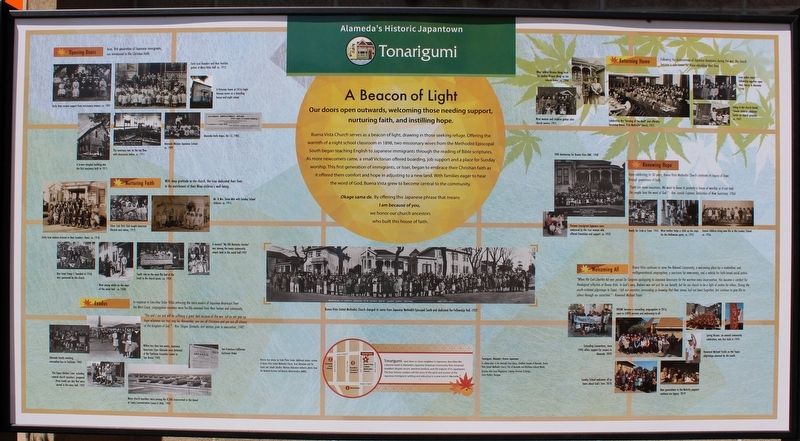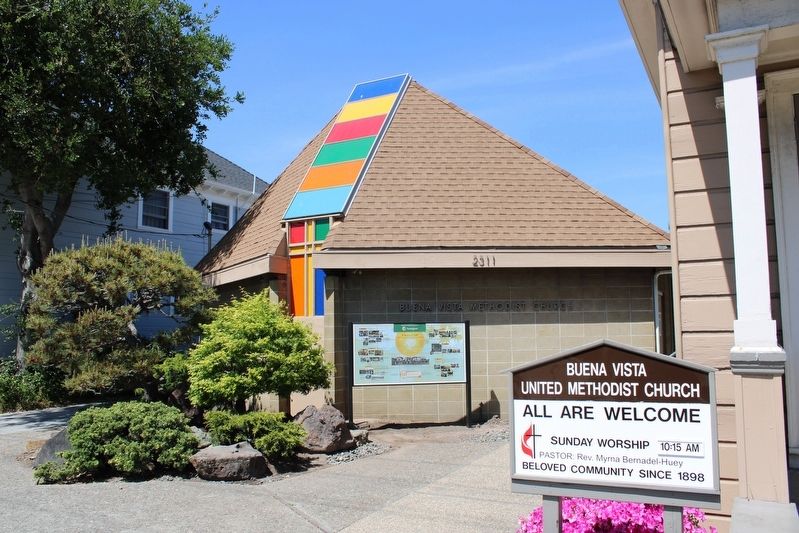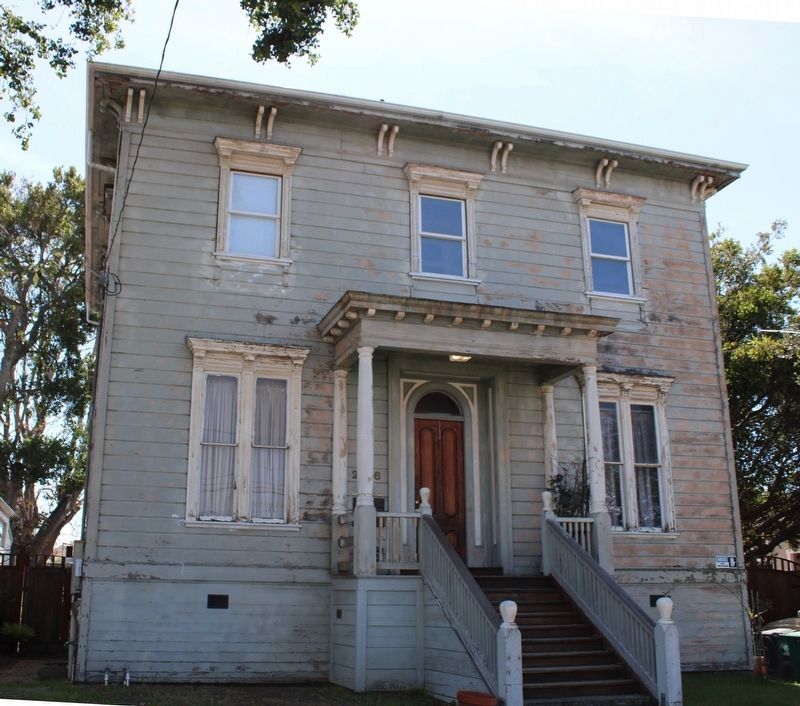Alameda in Alameda County, California — The American West (Pacific Coastal)
Tonarigumi
Alameda’s Historic Japantown
Our doors open outwards, welcoming those needing support, nurturing faith, and instilling hope.
Buena Vista Church serves as a beacon of light, drawing in those seeking refuge. Offering the warmth of a night school classroom in 1898, two missionary wives from the Methodist Episcopal South began teaching English to Japanese immigrants through the reading of Bible scriptures. As more newcomers came, a small Victorian offered boarding, job support and a place for Sunday worship. The first generation of immigrants, or Issei, began to embrace their Christian faith as it offered them comfort and hope in adjusting to a new land. With families eager to hear the word of God, Buena Vista grew to become central to the community.
Okage sama de. By offering this, Japanese phrase that means I am because of you, we honor out church ancestors who built this house of faith.
Tonarigumi, next door or close neighbor in Japanese, describes the cohesive bond in Alameda’s Japanese American community that remained steadfast despite racism, wartime hysteria, and the erasure of its Japantown. The four historic markers tell the story of the spirit and resolve of the Japanese immigrants settling and adjusting to a new land in Alameda.
Topics. This historical marker is listed in these topic lists: Asian Americans • Churches & Religion • Settlements & Settlers • War, World II. A significant historical year for this entry is 1898.
Location. 37° 46.13′ N, 122° 14.445′ W. Marker is in Alameda, California, in Alameda County. Marker is on Buena Vista Avenue south of Oak Street, on the right when traveling north. The resin marker is mounted to metal posts in front of the church. Touch for map. Marker is at or near this postal address: 2311 Buena Vista Avenue, Alameda CA 94501, United States of America. Touch for directions.
Other nearby markers. At least 8 other markers are within walking distance of this marker. A different marker also named Tonarigumi (about 400 feet away, measured in a direct line); a different marker also named Tonarigumi (about 500 feet away); a different marker also named Tonarigumi (approx. 0.2 miles away); Alameda City Hall (approx. 0.2 miles away); Alameda City Hall, 1895-96 (approx. ¼ mile away); They Brought Alameda the News (approx. ¼ mile away); Alameda Lodge No. 1015 (approx. ¼ mile away); ATK Baseball Field (approx. ¼ mile away). Touch for a list and map of all markers in Alameda.
More about this marker. Inset Images:
Buena Vista United Methodist Church changed its name from Japanese Methodist Episcopal South and dedicated the Fellowship Hall, 1927.
Opening Doors Issei, first generation of Japanese immigrants, are introduced to the Christian faith.
Early Issei receive support from missionary women. ca. 1907.
Early Issei founders and their families gather at Mary Halm Hall. ca. 1913
A Victorian home at 2416 Eagle Avenue serves as a boarding house and night school.
A brown-shingled building was the first sanctuary built in 1911.
The sanctuary was on the top floor with classrooms below. ca. 1911
Alameda Mission Japanese School, ca. 1909
Alameda Daily Argus, Oct. 13, 1903.
Nurturing Faith With deep gratitude to the church, the Issei dedicated their lives to the enrichment of their Nisei children’s well-being.
Early Issei women dressed in their Sunday’s finest. ca. 1918
Silver Link Girls Club taught American lifestyle and values, 1919.
Mr. & Mrs. Taroo Miki with Sunday School children. ca. 1915
Boy Scout Troop 7, founded in 1918, was sponsored by the church.
Nisei young adults on the steps of the social hall. ca. 1938
Youth ride on the open flat bed of the truck to the church picnic. ca. 1924
A musical “My Old Kentucky Garden” was among the many community events held in the social hall. 1937
Exodus In response
to Executive Order 9066 enforcing the mass exodus of Japanese Americans from the West Coast, congregation members were forcibly removed from their homes and community.
”You and I are and will be suffering a great deal because of this war. Let us not give up hope whatever our trial may be. Remember, you are all Christians and you are all citizens of the kingdom of God.” – Rev. Shigeo Shimada, last sermon prior to evacuation, 1942
Alameda family awaiting evacuation bus to Tanforan. 1942
The Topaz Kitchen Crew, including several church members, prepared three meals per day that were served in the mess hall. 1943
Within less then two weeks, Japanese Americans from Alameda were detained at the Tanforan Assembly Center in San Bruno. 1942
Many church members were among the 8,200 incarcerated in the desert at Topaz Concentration Camp in Utah. 1943
San Francisco California Exclusion Order
Returning Home Following the incarceration of Japanese Americans during the war, the church became a safe haven for those rebuilding their lives.
Nisei soldier Hiromu Akagi visits his mother Hisana Akagi as she returns home. ca. 1946
Nisei women and children gather after church service, 1951.
Celebrating the “burning of the deed” and officially becoming Buena Vista Methodist Church, 1951
Issei ladies enjoy fellowship together upon their return to Alameda. 1948
Living in the church hostel, Takeda children celebrate Easter on church grounds. ca. 1947
Renewing Hope Upon celebrating its 50 years, Buena Vista Church continues its legacy of hope through generations of faith.
”Faith can move mountains. We want to leave to posterity a house of worship so it can help the people hear the word of God.” – Rev. Junichi Fujimori, Dedication of New Sanctuary, 1966
50th Anniversary for Buena Vista UMC, 1948
Postwar immigrant Japanese were embraced by the Issei women who offered friendship and support. ca. 1953
Ready for Trick or Treat. 1955
Nisei mother helps a child up the steps for the Halloween party. ca. 1955
Sansei children bring new life to the Sunday School. ca. 1956
Welcoming All Buena Vista continues to serve the Beloved Community, a welcoming place for a multiethnic and multigenerational congregation, a sanctuary for newcomers, and a vehicle for faith-based social justice.
”When the Civil Liberties Act was passed by Congress apologizing to Japanese Americans for the wartime mass incarceration, this became a catalyst for theological reflection at Buena Vista. In God’s eyes, Redress was not just for our benefit, but for our church to be a light of justice for others. During the youth-initiated pilgrimage to Topaz, I felt our ancestors surrounding us knowing that their stories had not been forgotten, but continue to give life to others through our ministries.” – Reverend Michael Yoshii
BVUMC became a reconciling congregation in 2016, open to LGBTQ persons and welcoming to all.
Extending Connections, since 1990, offers support for seniors in Alameda. 2020
Sunday School welcomes all to learn about God’s love. 2018
Spring Bazaar, an annual community celebration, was first held in 1959.
Reverend Michael Yoshii on the Topaz pilgrimage planned by the youth.
New generations in the Nativity pageant continue our legacy. 2019
Historic Issei photos by Ozeki Photo Studio. Additional photos courtesy of Buena Vista United Methodist Church, Brad Shirakawa and the Imura and Takeda families. Wartime Relocation Authority photos from the National Archives and Records Administration (NARA).
Tonarigumi, Alameda’s Historic Japantown
A collaboration of the Alameda Free Library, Buddhist Temple of Alameda, Buena Vista United Methodist Church, City of Alameda and Rhythmix Cultural Works.
Kazumu Julio Cesar Naganuma, Creative Direction & Design, Grace Horikiri, Designer
Related markers. Click here for a list of markers that are related to this marker. Traces of Alameda Japantown, Life That Connects Us All, and Becoming a Japantown
Also see . . . Tonarigumi Dedication—Historic Markers Honor Alameda’s Japantown. Alameda Post
"On a beautiful fall evening in Alameda, 110 years after a Japanese immigrant community first formed here around 1912, a crowd gathered to pay homage to those early pioneers who created a Tonarigumi, or close-knit neighborhood."(Submitted on May 11, 2023, by Joseph Alvarado of Livermore, California.)
Credits. This page was last revised on May 17, 2023. It was originally submitted on May 11, 2023, by Joseph Alvarado of Livermore, California. This page has been viewed 81 times since then and 22 times this year. Photos: 1, 2, 3. submitted on May 11, 2023, by Joseph Alvarado of Livermore, California.


